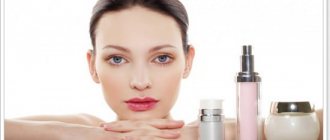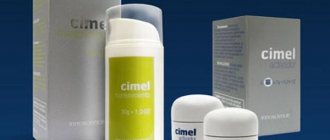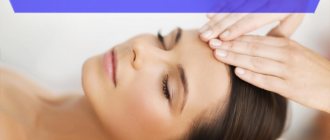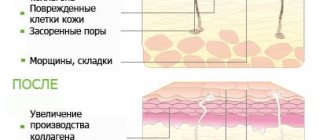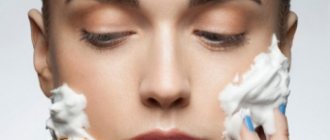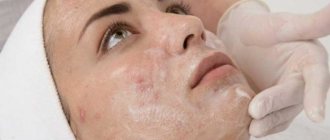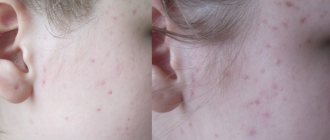What peeling to do in winter
This is true. Most exfoliating procedures should not be carried out in summer, late spring and early autumn. But when it comes to deep impact, winter is the best option.
It's all about the lack of ultraviolet radiation, from which we suffer so much, observing the sky constantly overcast for six months. For skin deprived of natural protection, solar radiation is fraught with burns and allergic reactions.
Let's figure out what kind of winter clothes every woman needs to make.
Medium peeling
For medium peels, acids such as retinoic, salicylic, and trichloroacetic are used. They are part of special products that the cosmetologist applies to the patient’s face. It is important to strictly observe the time it takes for the substance to penetrate the middle layers of the skin, otherwise unpleasant reactions may occur. As a result, the keratinized scales are destroyed, and the cells begin to actively recover - the process of self-rejuvenation begins. The skin is noticeably evened out, becomes fresh and radiant, pigment spots fade.
One procedure is not enough to achieve the desired result. You will need at least four of them, and at considerable intervals - from two to three weeks. That's why they postpone such serious peeling for the winter - the season is just enough to complete all the procedures and look great for the rest of the year.
Peeling gels with AHA and BHA acids
ARAVIA Professional chemical peels are multi-acid products. The drug formulas are based on AHA, BHA and PHA acids. The products perfectly remove dead skin cells and stimulate skin regeneration. All peels have an average pH value of 3. The concentration of acids is from 5 to 40%.
Indications for the use of peelings
- photo- and chronoaging
- hyperkeratosis
- violation of skin microrelief
- hyperpigmentation
- seborrhea
- acne and post-acne
- enlarged pores in the T-zone
Arabia peeling gels are professional products. To purchase peeling, you need to confirm your qualifications - upload a diploma or certificate.
OILY-Skin Control 30%
Acids: lactic - 20%, glycolic - 7%, salicylic - 3% Features: use on the face and body, can be applied to spots
An indispensable product for young skin. Works well on oily and combination acne-prone skin. Based on lactic acid - the most physiological acid for the body. Cleanses the ducts of the sebaceous glands, reduces acne and oily shine. Has a moisturizing and powerful anti-inflammatory effect. Lightens acne marks.
REPAIR-Skin Control 40%
Acids: gluconic (PHA) - 20%, glycolic - 15%, succinic - 5% Features: use for face and eyelids, does not irritate the skin
Corrects age-related changes, even in clients with thin mature skin. After the procedure, the face becomes fresh and radiant. Light peeling, despite the high concentration of acids. The peculiarity of the product is that it contains more glyconic acid - a polyhydroxy acid with a high molecular weight.
KERATO-Skin Control 35%
Acids: glycolic - 20%, salicylic, lactic, citric, tartaric and malic. Features: facial cleansing effect, quick and visible results.
The most powerful peeling with keratolytic effect. More powerful than REPAIR-Skin Control, despite the different percentage of acids. The fact is that KERATO-Skin Control contains a high content of glycolic acid - a component that penetrates deeper than others into the skin and causes stronger photosensitivity. The effect of glycolic acid is quick and pronounced. The complex of AHA and BHA acids enhances its effect.
Useful: after using peelings, there may be minor peeling. They usually appear in clients with hyperkeratosis. Another possible effect is skin tingling.
Laser peeling
This procedure is carried out using a laser. Its task is to literally dry out the upper layers of the skin, evaporating the liquid from them. As a result, their place is taken by deeper ones, untouched by any harmful effects. Naturally, all this does not go unnoticed by the skin. For a long time she remains very sensitive and vulnerable. Experts generally do not recommend their clients to leave the house during this period, even in winter.
If everything is done correctly, light expression wrinkles disappear, the skin begins to actively produce collagen and renew itself. The procedure is quite complicated, especially aftercare, but the game is worth the candle. The effect can last for five years, which is a long time without surgical intervention.
Autumn – peeling season
Autumn is the most favorable time for chemical peels.
Cosmetologists believe that the reason for skin aging is that self-exfoliation of keratinized epithelial cells decreases with age.
The main task of peeling is to stimulate the deeper layer of skin and remove dead cells. Cosmetologists also use chemical peeling to treat acne (pimples) and smooth out scars left after burns or acne.
There are the following types of peeling depending on the depth of exposure: superficial peeling, medium peeling and medium-deep chemical peeling. The choice of procedure depends on what result you want to achieve.
The most popular among superficial peels is glycolic peeling. Glycolic peeling is easy to use and is widely used in cosmetology and medicine. Of all fruit acids, glycolic has the smallest molecule, so it quickly penetrates the skin to the desired depth, causing the following biological effects: removal of dead skin cells from the upper layers of the skin; regeneration and renewal of the upper layers of the skin; increased production of your own hyaluronic acid and collagen; improved skin nutrition; better hydration and slowing down aging - as a consequence of the above.
To carry out glycolic peeling, drugs from the Japanese company Amenity, Co.Ltd, among others, are used. This peeling is truly unique, as it has no analogues among chemical peels presented on the global cosmoceutical market, either in the composition of the preparations, or in the results obtained, or in the sensations of patients.
The fact is that in addition to glycolic acid in a concentration of 5 to 70%, the chemical peeling used in the clinic includes 100% placenta extract and allantoin, which is also used in all professional procedures and forms the basis of home care products. The use of 100% placenta extract is the highlight of the clinic, which allows you to control the inflammatory situation, improve metabolism in cells, accelerate the process of tissue repair, and eliminate the development of allergies.
Thanks to the original combination of placenta and glycolic acid, the procedure is not aggressive for the skin, but at the same time gives a visible, excellent renewal result. As a result, fine wrinkles are eliminated, the elasticity and tone of the skin increases, pigment spots disappear, and the skin seems to glow from within.
ABR peeling is carried out using Israeli Holy Land cosmetics, which contains fruit acids with the addition of retinol (a natural form of vitamin A). It is excellent for problematic skin, reducing the number of inflammatory elements and deep inflammatory infiltrates. At the same time, the skin texture is evened out, scars are smoothed out, and pigment spots are lightened. There is a significant reduction in the frequency of relapses, the synthesis of elastin and collagen fibers is actively stimulated.
TCA peeling is a medium peeling based on trichloroacetic acid, which causes an active process of exfoliation of epithelial cells. During TCA peeling under the influence of trichloroacetic acid, areas of the skin turn white, as if in the cold. Cosmetologists call this “frost”. The stronger the frost, the more intense the peeling effect will be. Thus, the cosmetologist can visually see the force of impact, control and manage it. Depending on the depth of treatment, TCA peels can be used to achieve a variety of cosmetic goals. For mild wrinkles, the TCA peel may not be too deep, and vice versa, when smoothing the skin texture with deep wrinkles or scars, the strength of trichloroacetic acid can be increased.
TCA peeling is also used to improve skin turgor, even out its relief and tone, and correct hyperpigmentation not only on the face, but also on any other areas of the skin on the body, arms, legs, etc. To reduce skin irritation and reduce the likelihood of adverse reactions, the peeling composition includes Lactolin R, a drug obtained from colostrum.
A few secrets of successful peeling
If you decide to do peeling in winter, you need to carefully prepare for the procedure. You can’t just walk down the street, look into a beauty salon and come out looking beautiful.
Firstly, there are many contraindications for serious interventions, the most serious of which is the exacerbation of any chronic disease. To make sure everything is in order, it is best to undergo a medical examination.
If you are regularly bothered by herpes, then before surgery you need to consult a specialist and undergo a course of appropriate therapy. The fact is that after peeling you risk experiencing an exacerbation.
In order for the procedure to give a more noticeable result, two to three weeks before it you need to visit a cosmetologist and get a softening agent from him. It should be applied to the skin regularly.
The healing process will go faster if you take a course of vitamins and omega-3 fatty acids before peeling. This will be beneficial for the body as a whole. You will also have to give up smoking and alcoholic beverages. Cigarettes are especially harmful to healing because they interfere with normal blood circulation in the vessels.
Every girl wants to have healthy and clear skin. Each of the fair sex knows how difficult it is to achieve an ideal appearance, especially if problems appear frequently and for a long time. However, you can completely transform and refresh your skin if you start doing it in a timely manner. The winter period is an ideal opportunity for long-awaited changes.
It would seem that frost and cold are in no way associated with matte and clear skin, but cosmetologists are in a hurry to dispel this misconception. The fact is that it is in late autumn and winter that the season of peelings and similar facial procedures should begin. The essence of peeling is to cleanse the skin of lifeless and dead cells, which helps restore important functions and acquire a smooth, toned and clean appearance. Having done the procedure once, you will quickly notice the first results and continue the course you started.
Professional peeling in a beauty salon can solve almost all external problems: from facial wrinkles, scars to serious (deep) skin damage. The procedure is carried out at an exclusively specified time, not at the whim of cosmetologists, but due to the weather conditions in summer and spring. The fact is that excess sun exposure on treated skin can aggravate the situation and lead to pigmentation.
Top facial peels for autumn
What is peeling
Facial peeling is a term in cosmetology, which translated from English as “peeling” means “cleansing, exfoliation.” This cosmetic procedure is aimed at cleansing the skin by removing the top layer of the epidermis.
The essence of this action is that dead particles of the dermis are removed, and this is perceived by the body as a signal for speedy regeneration. At the same time, active production of collagen and elastin is stimulated in the cells, which improve the quality characteristics of the skin.
Considering the seriousness of the procedure, experts at barb.ru do not recommend performing the procedure at home. Improper use of formulations can lead to unnecessary trauma to the skin. You can find a cosmetologist and sign up for facial peeling in Moscow in the corresponding section of the barb.ru website. There, the masters indicate the approximate cost of the procedure. Using the before and after photos in the specialists’ profiles, you can evaluate the effectiveness of different types of peelings.
In what cases is peeling indicated?
The facial peeling procedure is necessary for those who have skin problems of varying nature and complexity.
There are a great variety of procedures in this category. Each of them is aimed at solving specific problems. A specialist should select a specific type of peeling based on the client’s complaints and the characteristics of his skin.
With facial peeling you can eliminate or correct the following problems:
- mud accumulations on the skin;
- acne, comedones, molium, scars;
- stagnation of blood circulation and lack of nutrients;
- uneven surface: skin folds and other defects;
- hyperpigmentation;
- increased skin oiliness;
- photo- and chronoaging, loss of facial tone and elasticity.
What does facial peeling do?
- exfoliation of dead cells;
- deep cleansing of pores;
- smoothing skin texture;
- antioxidant effect;
- removal of freckles and age spots;
- stimulation of collagen and ceramide synthesis.
What to look for when choosing a peeling Based on the method and technique, cosmetologists distinguish chemical, mechanical, physical and enzymatic and other peelings.
Read: RF face lift. What is it and why?
The chemical version of peeling involves the use of acids of varying degrees of concentration. They actively interact with tissues and dissolve them. This cleaning is especially suitable for the cold season.
Mechanical peeling is based on micro-grinding of the skin, where products containing natural or artificial abrasive particles are used. This facial cleansing option is not suitable for dry and sensitive skin types, as it can create microdamages on the surface of the dermis.
Using physical manipulation, the skin is exposed to special ultrasonic devices that conduct microcurrents at a certain frequency. Physical peeling is quite gentle and can be done at any time of the year.
Based on the depth of penetration into the layers of the epidermis, they are divided into: superficial, medium and deep peeling. The first affects the stratum corneum and exfoliates only dead skin particles.
Median, or superficial-median, affects the dermis located within the basement membrane. Deep peeling reaches the mesh layers and has a maximum effect on the facial skin, and also requires subsequent restorative therapy.
Among all the variety of cosmetic procedures, it is necessary to make a smart choice in favor of the one that will be most effective for a particular person. The choice is determined by the characteristics and condition of the skin, the client’s age, the presence of allergies and chronic diseases. The time of year can have an equally important impact. In summer, the skin is actively exposed to sunlight, so peeling should be light. During the cold season, you can choose deeper types of cleaning.
For example, it is better for women with acne to give preference to a chemical peeling option, while for those suffering from oily skin with comedones, mechanical peeling is suitable. TOP procedures that can be done in Moscow salons
Glycolic peeling
This is a cosmetic procedure aimed at deep cleansing the skin using glycolic acid. This substance acts more harshly than fruit or lactic acid, but does not penetrate deeper than the middle layers of the epidermis.
Read: Cucumber face mask and what are its results for the skin
The advantage of glycolic acid is its versatility: it is suitable for all ages and skin types. At the same time, it is highly effective and does not require anesthesia. Recovery may take 5 to 7 days. Yellow (retinoic peeling) refers to the superficial-medium peel. The basis of this procedure is a derivative form of vitamin A. This popular type of peeling has established itself as one of the best options for getting rid of signs of aging. In addition to eliminating wrinkles, such cleaning is indicated for those with dry skin and age spots.
The procedure does not cause any discomfort other than a slight tingling sensation. The recovery period is quite difficult, but only 2-3 days.
Mechanical peeling is the most common among superficial procedures. To carry out mechanical manipulations, various products based on scrubbing particles are used. They are able to remove the stratum corneum of the skin, improve blood microcirculation, and have a slight lifting effect.
This type of cleaning does not require serious restoration measures, and unlike acids, it is less likely to cause allergies. Laser peeling is the destruction of the upper stratum corneum of the dermis under the action of a laser beam. The device affects the connections between cells, after which the stratum corneum of the epidermis is exfoliated.
The procedure is used to remove significant imperfections from the surface of the facial skin: wrinkles, unevenness, scars, scars, age spots.
Due to laser exposure, the production of elastin and collagen is accelerated and blood flow improves. First, crusts appear on the skin, and later it peels off in flakes.
Enzyme peeling is the lightest and most gentle peeling that is suitable for sensitive facial skin. The procedure involves the use of raw materials of enzymatic origin (bacterial, animal or plant origin). The specialist himself selects the base enzyme or complex of enzymes. Enzyme peeling is used to treat acne, smooth out irregularities, eliminate comedones, blackheads, and minimize wrinkles. This cleaning can be done in any season.
Three types of peelings: we understand the features and differences
Of course, the most accurate answer can be obtained in a cosmetology salon after preliminary diagnosis. But no one has yet prohibited knowing general information. The most common “troika” of peelings are:
- Chemical. After applying the selected chemical solution, exfoliating and restorative functions are launched. Peeling most likely will not give you pleasant sensations during application. Therefore, girls with a high pain threshold should think several times before the procedure;
- Ultrasonic. Now it is called hardware cleaning, but the essence of the method does not change. A special device helps to resolve congestion and improve appearance;
- Laser. Otherwise, peeling can be called laser resurfacing. The most effective, and therefore expensive pleasure (you will have to pay more than 5,000 rubles at a time). The effect on the skin occurs thermally. Due to high pain, anesthesia may be required.
Types of peelings by depth of penetration
Procedures vary in depth of penetration and subsequent recovery period.
For example, after deep peeling (suitable only for women over 50 years old) aimed at destroying the epidermis, the skin will “come to its senses” in one to two weeks. The result, by the way, deserves patience. Often, with the help of deep peelings, the effects of post-acne, wrinkles and nasolabial folds are corrected. Using medium peeling helps eliminate early aging, first wrinkles, acne and other imperfections. Adaptation does not take more than 7 days. Superficial peelings with salicylic, lactic, and citric acids are suitable as a preventive measure only for girls with good skin.
It is important to remember that visiting a solarium, sauna, or walking in the open sun after peeling is completely prohibited. If possible, it is necessary to reduce your time on the street, giving preference to home gatherings.
What else can you do to please your face during the frosty seasons?
If you have not yet been able to decide on the aggressive effects of acids and lasers, this does not mean that a trip to a cosmetologist should be postponed until next winter.
On the eve of the holidays and huge financial expenses, it is better to donate a small amount for your loved one. Fortunately, you can look well-groomed and fresh even after the usual mechanical, combined or vacuum facial cleansing. The difference between a professional approach and a home one is the use of special devices that minimize skin trauma. But, alas, you won’t be able to avoid the pain: in order to rid you of impurities as much as possible, the cosmetologist will have to press a little (you can expect special sensations from cleaning the pores on your nose). Those who want to leave the cleansing “for dessert” and do it on the 30th of December should prepare themselves for the fact that the redness and wounds will disappear within 2-4 days.
Of course, this is not the entire list of what a cosmetologist can offer a girl. Depending on your skin type, they will select appropriate care for you, recommend a mask, scrub, or give recommendations on further actions.
You shouldn’t neglect cosmetology, because the sooner you start solving existing problems, the sooner you’ll say goodbye to them forever. Reflection in the mirror can instantly improve self-esteem and mood, and therefore it is in your interests to be beautiful every minute.
When choosing a peel, almost all of our patients are lost and don’t know what to look for. First of all, calm down and stop nervously searching for all possible information on the Internet. Why? Because no one other than a doctor can tell you exactly which type of peeling is right for you. Always keep in mind that everyone has different characteristics, different skin types, different reactions. Therefore, everyone is treated individually. So your best decision would be to schedule a consultation with a cosmetologist at Cleo Line.
And already during the examination, the doctor will be able to select the appropriate peeling for you. Their diversity is determined by:
- depth of impact - there are superficial, medium and deep peels
- having an effect - depending on the composition, peelings fight different skin problems. This may be an uneven complexion, acne, scars, peeling, increased sebum secretion, etc.
- seasonality - there are peelings that can be done at any time of the year, but there are also those that are indicated only in the autumn-winter period
Why is it recommended to do peelings in the autumn-winter period? The answer is simple - it's all about the activity of the sun. In winter, the sun is least active, so the risk of injury to the skin after peeling is reduced significantly. And excessive exposure to the sun after peeling can injure the skin, cause unpredictable reactions and hyperpigmentation, since the skin after treatment remains sensitive to any environmental changes. If you want everything to go smoothly (in every sense), we recommend that you do peelings in the autumn-winter period. Another advantage of winter peelings is the reduction in the concentration of dust and contaminants in the air. We want to have clear skin, right?
What peelings are available
Peels that can only be done when sun activity is low include:
It is aimed at removing freckles and other age spots. This peeling perfectly moisturizes the skin due to the acids it contains (salicylic, lactic) and resorcinol. The depigmenting effect is achieved through hydroquinone, kojic and citric acids. The full rehabilitation period lasts about 10 days.
Its main difference is that it copes well with the signs of aging and skin aging. This peeling can be applied not only to the face, but also to the neck and even to the décolleté area. Retinoic peeling is a medium peeling that has an effect down to the basal layer of the skin. This means that the rejuvenation process will be more serious than with superficial peels. Retinoic peeling also removes fine wrinkles and normalizes collagen synthesis in the skin.
Also classified as medium peels. Its main component is trichloroacetic acid, the concentration of which the doctor selects independently after examining your skin. Each patient at Cleo Line has individual treatment! Indications for TCA peeling will be: enlarged pores, flaky skin, hyperkeratosis (a skin condition in which there is a thick stratum corneum of cells), and the presence of hyperpigmentation. We can say that TCA peeling is universal, as it combats the main and most common problems.
stands on a par with the middle ones, but in fact it is superficial. This peel works on oily skin, pigmented skin, acne marks. The Jessner peel does not work quite like regular peels. If the usual ones are washed off at the end of the session, then this peeling is left on the face. A special composition is applied to the top, which acts as a protective film. In addition, a protective cream is applied to the face.
A mandatory procedure for those who have constant rashes and pimples on their skin. Salicylic acid acts as a disinfectant that kills all bacteria that cause acne and comedones. At the same time, it regulates the functioning of the sebaceous glands and dries the skin.
These are the main peels that are usually done in autumn and winter. On the recommendation of a doctor during these times of the year, of course, you can do all-season ones. But they are usually superficial and are not aimed at serious skin treatment.
Before carrying out the procedure, consultation with a doctor is required.
We often hear from cosmetologists that autumn is the time for peeling. Why do experts insist on this particular season, what is the secret? After all, we believe that the best time for peeling is when the problem has just arisen and has not received a “big resonance.”
But everything is not as simple as it seems at first glance. The time of peeling must be chosen wisely so that the expected effect does not cause complete disappointment. Are there many questions that are not yet answered? Let's sort it out in order.
The autumn season is marked by a decrease in solar activity, ambient temperature, changes in humidity and other climatic indicators. In addition, autumn gives way to summer, when our skin is exposed to hot sun, dry air and other physical factors.
Peeling in the fall is as necessary as air. After all, it will rid the epidermis of accumulated keratinized particles, which, due to objective reasons, are quite difficult to exfoliate in the summer. And these are not all the reasons why the cleansing procedure is carried out at this time of year.
- High-quality removal of pigmentation. Ultraviolet radiation provokes increased production of melanin and dark spots appear on the face, as the most exposed part of the body.
- Signs of photoaging. Again, our beloved sun “tried” and rewarded us with a network of fine wrinkles, especially if no protective agents were used. The procedure will help to effectively resolve the problem.
- High ambient temperatures, low humidity, changes in climatic conditions (a trip to the sea or to the mountains) provoke excessive dryness of the skin. It begins to peel off and microcracks form, which can easily become infected. Again, autumn peeling helps to cope with this problem and has a preventive effect, preventing inflammatory processes and all the “delights” associated with them.
- Although autumn is rightfully considered the richest time, the change of seasons always causes vitamin deficiency. Peeling compositions not only cleanse the epidermis, but also saturate it with moisture and nutrients. In addition, the skin's sensitivity to nourishing and moisturizing cosmetics improves, and blood circulation and regeneration processes are stimulated.
The main criteria for the justification of autumn peelings:
- solar activity decreases in the autumn season, which is very good. Why? After peeling procedures, the skin becomes very sensitive, thin and vulnerable. It will take some time to recover (from a week to several months, depending on the type of procedure). Natural ultraviolet light will not harm delicate skin;
- The course of peeling can be divided over time. To achieve the desired visible effect, cosmetologists advise doing several manipulations over a certain period of time.
If you don’t have the time, financial capabilities or desire to visit a salon for professional cosmetic procedures, this is not a reason to refuse independent cleansing sessions. Fortunately, for such purposes there are many purchased products and recipes for preparing active compounds yourself.
Now we are considering the aspect of what peelings can be done in the fall. Based on common sense, it is advisable to carry out almost all of these procedures during the period of least solar activity in order to minimize the negative impact of ultraviolet radiation on delicate skin.
Among the proposed autumn facial peels, each woman will be able to choose the appropriate option for herself, taking into account her existing problems and individual characteristics.
Mechanical peelings are the most common and popular among superficial procedures. They can be carried out both in salons and at home. The protocol involves the use of products with abrasive particles (that is, scrubs, as we used to call them). These can be purchased products or home-prepared formulations. Expected effect:
- mechanical removal of keratinized particles;
- improvement of blood microcirculation;
- stimulation of internal processes - oxygen metabolism, absorption of nutrients, skin regeneration, synthesis of collagen and elastin;
- getting rid of facial wrinkles;
- removal or minimization of pigmentation;
- light lifting effect.
Physical peelings or hardware peels are carried out only on the recommendation of a cosmetologist and it is better to carry out manipulations in the salon. These are laser, ultrasound or vacuum procedures. They will help:
- get rid of acne and post-acne;
- remove age spots, even pronounced ones;
- fight comedones, sebaceous plugs, acne, inflammatory processes;
- stop the aging process;
- stimulate the synthesis of your own protein compounds responsible for the condition of the skin;
- improve color, even out microrelief, tighten the oval of the face.
To carry out peelings in the autumn with maximum effect, you should pay special attention to chemical procedures. Such manipulations cause a targeted chemical burn, which forces the body to seek hidden reserves for recovery.
Chemical peels are very diverse. They are divided into several types according to the depth of impact on epidermal tissue. And each of the options effectively combats a whole list of problems.
- Superficial procedures are the most gentle. To carry them out, products with a low concentration of acidic components are used. These are mainly fruit or lactic acids. Sessions can be carried out either with a cosmetologist or independently.
- Medium exposure involves the use of formulations with a higher concentration of aggressive substances. This is a salicylic peel using trichloroacetic acid, retinoic (yellow). With their help, you can solve more serious problems, get rid of severe pigmentation, acne marks, and wrinkles. The structure of the skin is restored, color and microrelief are improved.
- Deep peeling is a procedure similar to plastic surgery. It is carried out only in a hospital setting. The effect is so deep that even the basal layer of the dermis is affected. The manipulation is quite painful and is carried out only under anesthesia. Since the process uses phenol (a toxic substance), monitoring of cardiac activity is necessary. Preparation for such a procedure is very serious, as it has a long list of contraindications.
Medium and deep peelings are purely salon methods of cleansing and rejuvenating the skin. And if some types of the middle are still allowed for independent implementation, then the deep is entirely the prerogative of specialists.
As we have already found out, autumn is the time for peeling. What do cosmetologists advise regarding the choice of procedure?
- Mechanical peelings can be carried out at home, using both purchased and self-prepared products. To cleanse in the fall, you can use coffee grounds with honey and cream, sea salt (crushed), sugar, oatmeal and other products that you always have on hand.
- Hardware peelings are carried out by experienced specialists according to clear indications. Especially laser and ultrasound. Despite the apparent simplicity of the manipulations, their painlessness, minimal side effects and a relatively short recovery period, the procedures have contraindications that only a professional can take into account.
- Superficial chemical peels should be selected taking into account the characteristics of your skin. So milk peeling is an ideal option for young epidermis with a tendency to dryness and few problems. Glycolic – for oily skin with signs of age-related changes.
- The average effect is justified in the presence of pronounced problems and age-related changes. Salicylic - for problem skin, trichloroacetic is recommended for women over 35 years old, retinoic - for loss of color and decreased turgor.
- Deep - only for women over 45-50 years old for clear indications. Conducted once a year at least. However, experts say that such an effect with adequate care is enough for a period of up to 3-5 years.
- The course of superficial procedures ranges from 5 to 7 at weekly intervals. Next, you need to use soft, gentle scrubs at home regularly at least once a week to maintain the effect.
- Medium effects, depending on individual characteristics, may require from 3 to 5 sessions with an interval of 2-4 weeks.
Regardless of the time of year, it is necessary to use sunscreen. After peeling, even in autumn, before going outside, you need to use products with a UV protection index of at least 30.
Note! Cosmetologists warn that winter is not the best time for cleansing procedures. Frost, wind, changes in temperature and humidity (outdoors - indoors) have a detrimental effect on the condition of thin, delicate skin after peeling.
Briefly: when and what peelings to use
The main guideline in choosing a peel is the client’s skin condition and complaints.
- For problematic skin with oily shine and enlarged pores, OILY-Skin Control is ideal. The drug regulates the functioning of the sebaceous glands and fights inflammatory processes. It is gentle and does not dry out the skin.
- If the client is concerned about age-related changes, we recommend REPAIR-Skin Control. A great option if you need a quick anti-aging procedure. The drug will return a healthy glow to the face, eliminate shallow wrinkles and hyperpigmentation.
- For severe skin imperfections, we recommend KERATO-Skin Control. The most powerful product in the ARAVIA Professional peeling line. Works with hyperkeratosis, seborrheic keratosis, photo and chronoaging.
Summary
Let's summarize. The effectiveness of peelings in the autumn period is the highest. It is at this time that you can use more active products to tidy up your skin.
But you should also remember that aggressive procedures should not be abused. After all, the body’s internal hidden reserves are not limitless. There may come a time when the “safety margins” simply run out. Then no force will force your body to recover. After all, the skin is the largest organ, which also has its ultimate maximum.
It has long been no secret what peeling is, how and where it can be done. Its main purpose is to cleanse the skin and rejuvenate it. It is thanks to the right type of peeling that the skin can be restored to its former freshness, health and attractive appearance.
The main thing is to choose the right procedure and be sure to consult with a cosmetologist who will tell you not only how to do the procedure, but also select an individual course of cleansing and rejuvenation of the skin, which is important in such a serious procedure for the skin.
Peeling products and types of procedures
In cosmetics stores, you can often buy peeling masks that act on the skin mechanically due to the microgranules they contain. But in professional cosmetics stores you can buy more aggressive products for this procedure and most often they are based on acids. These types can be performed in salons and also at home, subject to all precautions and rules of the procedure.
There is also vacuum peeling and laser peeling, which are definitely carried out by a specialist using special equipment.
Frequency of peeling
In order to get the desired result, one peeling procedure is not always enough. Most often, a course of skin rejuvenation and healing is required, which also directly depends on the skin type, type of peeling and the desired result. Therefore, only a specialist in this field can answer the question of how many procedures need to be done.
Most chemical peels take a course of 4-6 procedures with an interval between each procedure of 7 days for oily and normal skin, 14 days for normal skin, 14-21 days for dry and very sensitive skin. Although here too it is impossible to give unambiguous recommendations, since, for example, peeling with citric acid is carried out according to this schedule, but peeling with calcium chloride can be done every other week for any skin type.
Pros for carrying out procedures in winter
Lack of “active” sun, or more precisely, ultraviolet radiation
It is this that can spoil and sometimes negate the results of laser or chemical resurfacing if the skin is not sufficiently protected.
Judge for yourself, this is what the skin looks like after medium and deep sanding:
Face immediately after peeling. The wounds are clearly visible.
Face after peeling: persistent erythema, swelling. Moisturizing and regenerating products are no less important than the peeling itself.
Considering that the healing and regeneration process does not take one day, but lasts for weeks and even months (depending on the depth of resurfacing), the patient will have to somehow coexist with the environment with this condition of the facial skin all this time. And, of course, in winter it is much easier to “coexist” with the sun (which, in fact, does not exist).
Face after peeling. The crusts have already disappeared, but the face “like it was burning in a tank” will take weeks, perhaps months, to recover.
No heat
The body and face do not sweat as intensely in winter as in summer. There is no excess sebum secretion - this is especially true for oily skin. Accordingly, the process of regeneration of skin damaged by traumatic procedures occurs without interference.
Moreover, cool air is a natural “cooling and soothing factor” after peeling.
Lack of seasonal summer temptations
No matter how you tell the patient that “sunbathing is prohibited”, “you can’t go to the beach”, “protect and cover your skin” - no, no, and he will go to great lengths, justifying himself by saying that he is not directly violating your prohibition, no, no!
For example, after a chemical peel, a patient went to perform feats of labor at her dacha - she dug up the beds and planted or removed something there. The result: a thick layer of earthen dust on the face, mixed with sweat, and stuck to fresh wounds in a dense layer, 5 hours in the sun. But she is sure: “I didn’t sunbathe! And I wasn’t on the beach! And the dacha is sacred. It’s only the weekend, we need to do it urgently, or everything will be lost.”
At the dacha: dreams vs reality
How to peel correctly
Any type of peeling means complete cleansing of the skin, so the skin must first be cleaned mechanically using even ordinary water. Ideally, it’s a good idea to steam your skin in the bath or shower; you can make a steam bath for your face. Most often it is done on the face, neck and décolleté. They should also be cleaned and steamed.
After this, the peeling mixture is applied to the skin with light massage movements. The eye and lip areas are excluded when applied; for some types of peeling, the mixture should also not be applied to the area between the nose and lips.
Peeling on the skin is maintained for the required amount of time and then carefully washed off. The mixture must also be removed from the skin correctly. To do this, apply a small amount of water to the skin and rub the mixture over the skin again. Gradually the amount of water increases, and if necessary, the remaining peeling can be removed with special cotton pads.
What is peeling and how to do it correctly
Chemical peeling of the face by a cosmetologist
Facial peeling at home
Home Peeling. Malysheva About Home Peeling
Chemical PEELINGS. What do you need to know?
After peeling, the face and other areas of the body to which the mixture was applied are usually washed with cold water. But some of them can be washed off with heat, so during the procedure you must follow the rules of the procedure.
It is very important to apply appropriate skin care product after the procedure. Most often this is a moisturizing face cream, but in some cases it is recommended to apply a nourishing or even baby cream.
Precautions for the procedure include any damage to the skin, excessive sensitivity, irritation, as well as any contraindications to one or another type of peeling.
Winter is the perfect time for exfoliation!
What does peeling give us and how useful is it? Peeling is a skin cleansing procedure that can be carried out in several ways and can be of varying depths of impact. The principle of operation of any type of peeling is the removal of the stratum corneum, which allows the skin to be fully saturated with oxygen and nutrients, it is rejuvenated, wrinkles and various skin irregularities, which are more noticeable and deeper on dry, non-exfoliated skin, are reduced. It is best to carry out peelings from late autumn to early spring, since during this period the sun is least active and will not cause skin pigmentation. I offer two types of peeling - enzyme and fruit with AHA acids, both peels are superficial, since deeper types of peeling should be carried out under the supervision of a specialist. Superficial peels do not cause severe redness or peeling of the skin, and they are safe to perform at home.
Enzyme peeling is created on the basis of enzymes, that is, enzymes. Enzymes are biologically active substances that stimulate various processes in the human body. During the enzymatic peeling procedure, dead and keratinized particles of the epidermis are removed and dissolved using a weak solution of fruit acids. Fruit acids are obtained from various plants, both exotic, such as papaya, sugar cane, kiwi, manuka, and more common ones - orange, grapefruit, grapes, pineapple, wheat, aloe vera. The procedure is carried out on the skin of the face, eyelids, neck and area neckline The composition remains on the skin for 10-30 minutes and then is removed. During the procedure, you may feel a slight tingling sensation and your face may “burn.” The intensity of this sensation depends on the individual characteristics of the skin. After the procedure, it is not recommended to touch your face during the day. Carry out the peeling procedure for dry skin once every 7-10 days (5-8 procedures), for oily and mixed skin you can peel twice as often. Enzyme peeling stimulates skin cell renewal processes. The result will be a healthier appearance of the skin, an increase in its tone, and smoother relief. Enzyme peeling should not be expected to solve significant skin problems - it will not remove deep wrinkles or eliminate scars.
Fruit peeling - alpha hydroxy acids, or AHA acids, are natural substances, mainly of plant origin, which is why they are often called fruit acids. When using AHA acids, cell regeneration is activated, the skin becomes fresher and more elastic. The flow of moisture from the lower layers of the skin to its surface increases, the skin is moisturized and softened. This is very important for dry skin. The lipid balance is normalized, the ducts of the sebaceous glands are cleaned, therefore, the oiliness of the skin is reduced, and the appearance of comedones and acne is prevented. Skin areas with hyperpigmentation are lightened. In addition, regular removal of dead cells facilitates the penetration of the active components of creams and serums into the skin. Fruit peeling is carried out in a course of 4-6 procedures over 1.5 months, i.e. with an interval of 7-10 days. The duration of the superficial fruit peeling procedure is 10-20 minutes. You may experience a slight tingling or burning sensation when applying fruit creams or peeling lotions. The time of such exposure depends, first of all, on the individual sensitivity of the skin. The time of exposure to fruit acids is considered the most important factor that determines the effectiveness of this procedure. However, it is not strictly fixed, as it depends on the barrier properties of the skin, the thickness of the stratum corneum, skin type, sensitivity to acid, and the severity of cosmetic defects. The exposure time is selected individually. The “effect” time ranges from 6 months to a year. Then the fruit peeling procedure can be repeated.
During peeling, the skin becomes more sensitive and susceptible to external factors, since the upper stratum corneum of the skin is exfoliated, and new young cells have not yet created their natural barrier. During this period, the skin must be additionally cared for with serums or masks, moisturized, protected and stimulated the growth of new cells. During the day, you need to use a cream with UV protection.
We must not forget about contraindications for peeling:
· Pregnancy and lactation · Colds and fever · Chronic diseases in the acute stage · Herpes in the acute stage · Infectious skin diseases · Predisposition to the formation of keloid scars · Damage to the skin · Diseases of the blood and cardiovascular system · Oncological diseases · Skin diseases in acute stages (eczema, allergic dermatoses, atopic dermatitis, psoriasis, etc.) Diabetes mellitus
Take proper care of yourself and always be beautiful!
When is peeling necessary?
Many women are interested in whether it is possible to do peeling in winter? But indeed, it has its own seasonality. Most often, autumn is called the period of peeling, because at this time of year nature goes into a period of rest, she sheds her clothes for future renewal. Our skin also needs this - to cleanse and get rid of dead cells, dirt and dust.
In winter, the skin is exposed to frost and wind, so it becomes extremely sensitive and irritated. During this period of the year, it is undesirable to carry out any procedures to remove dead skin cells, and cosmetologists do not even recommend using decorative cosmetics, especially foundations, for some women.
Still, light superficial peeling can be done in winter if necessary. If you give the skin some time after the procedure to recover and rest, then such a procedure can be carried out. But in the spring, these procedures are strictly contraindicated for any skin type, since it is during this season that the sun becomes active and the skin can simply become covered with pigment spots.

